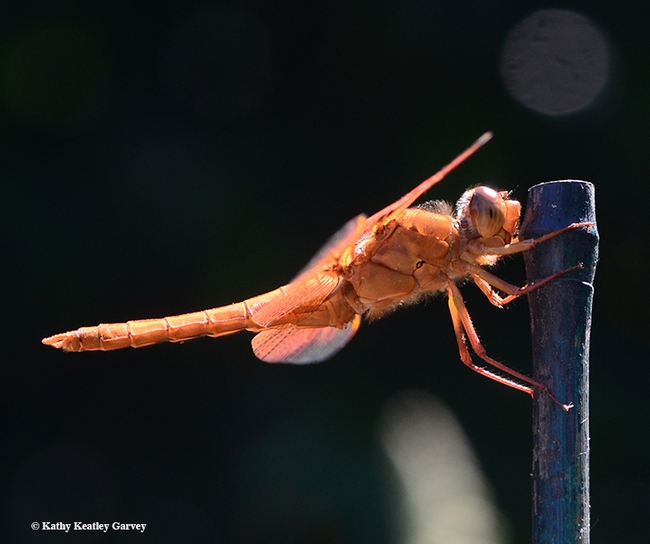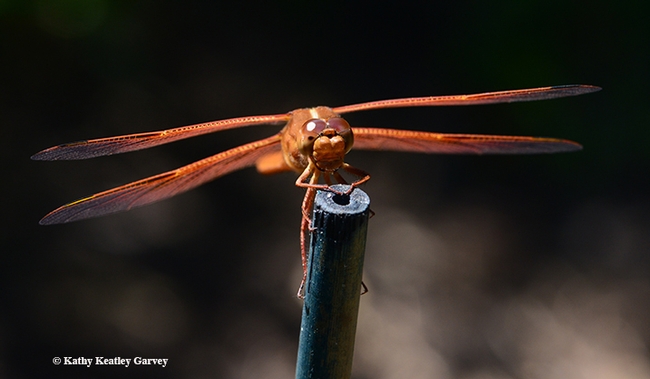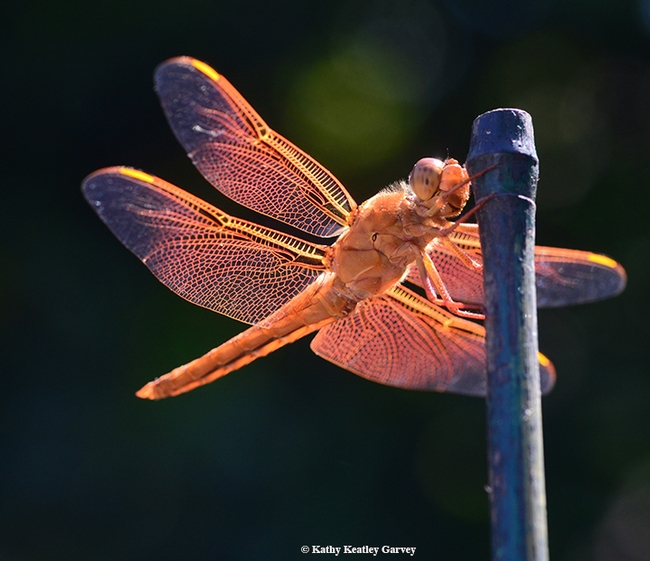- Author: Kathy Keatley Garvey
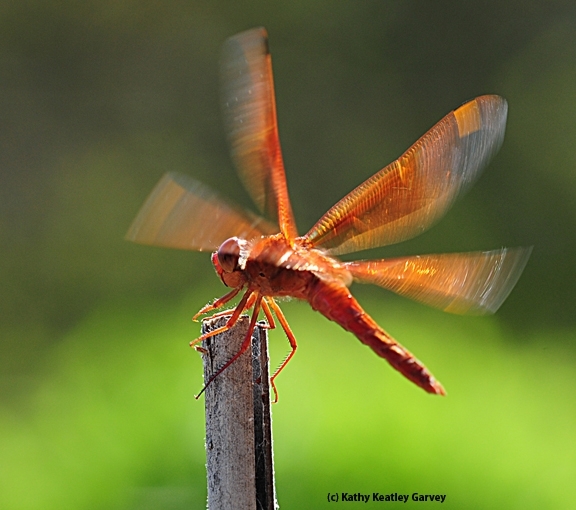
In his essay, The Decay of Lying (1889), Irish poet and playwright Oscar Wilde (1854-1900) wrote: “Life imitates art far more than art imitates life,” adding “the self-conscious aim of life is to find expression, and art offers it certain beautiful forms through which it may release that energy.”
Take the case of a mural on Main Street, Vacaville, the work of Cheyenne Renee Marcus. The artist, based in Covington, Va., painted the mural in 2022 with plans to paint 50 murals in 50 states. All in small towns. (See the Vacaville project on YouTube)
Her mural shows a young girl in a billowing blue dress blowing the seeds off a dandelion--perhaps she's making a wish?--while a flameskimmer dragonfly zigzags away.
The dragonfly is firecracker red, in sharp contrast to the light blue dress.
The mural is located at 444 Main St.-- actually in the alley--on the wall of a building now occupied by a wine bar, Main Grape.
One thing's for sure, that flameskimmer is a main attraction. On a cold, wintry day, it's a burst of joy and spirit, much like the little girl blowing the seeds off a dandelion, destination unchartered, but the making of a promise.

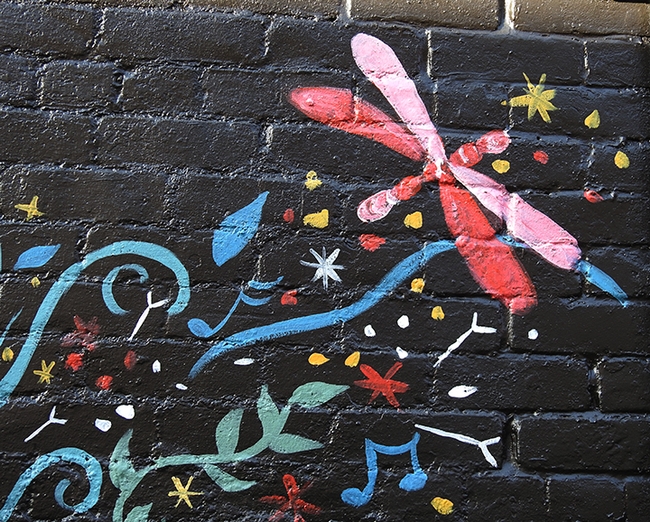

- Author: Kathy Keatley Garvey
"Sweat bees have earned their common name from the tendency, especially of the smaller species,to alight on one's skin and lap up perspiration for both its moisture and salt content."
So write University of California scientists in their award-winning book, California Bees and Blooms, a Guide for Gardeners and Naturalists.
California has some 1600 species of undomesticated or wild bees, point out the authors (Gordon Frankie, Robbin Thorp, Rollin Coville and Barbara Ertter).
And one of them is the sweat bee, Halictus ligatus, a member of the family Halictidae. It's a medium-sized, ground-nesting bee with a striped abdomen.
This week one of these species (as identified by research scientist John Ascher) looked especially striking on a Black-Eyed Susan, Rudbeckia hirta, a member of the Aster (Asteraceae) family. Both the plant and the bee are natives.
Several years ago we managed to photograph a flameskimmer dragonfly, Libellula saturata, munching on one of these sweat bees. Not a good day for that little gal!
No dragonflies were around, however, when we watched this one foraging on a Black-Eyed Susan.
Did you know that the Black-Eyed Susan is the designated state flower of Maryland? And that it was the inspiration for the University of Southern Mississippi's school colors (black and gold)? And that it's a larval host to butterflies such as the bordered batch, gorgone checkerspot and silvery checkerspot?
Who knew? If you plant it, though, be aware that it is toxic (when ingested) to cats.
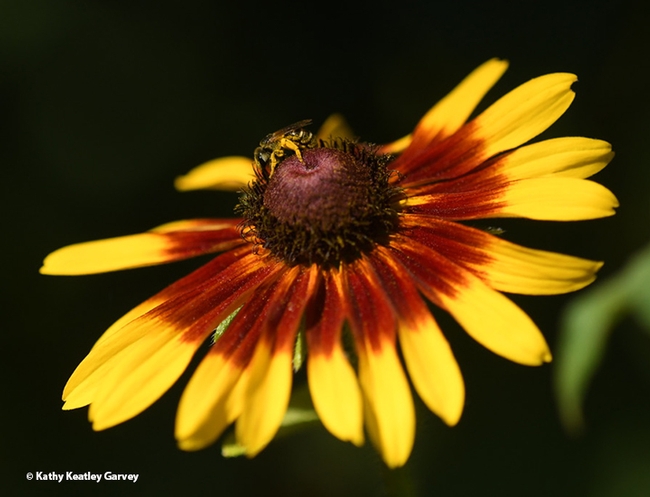
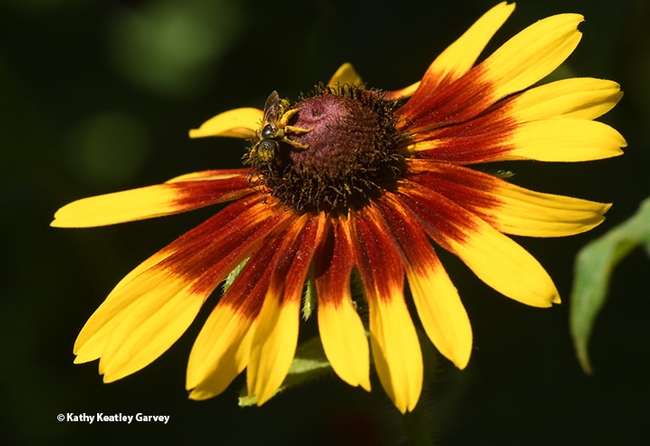
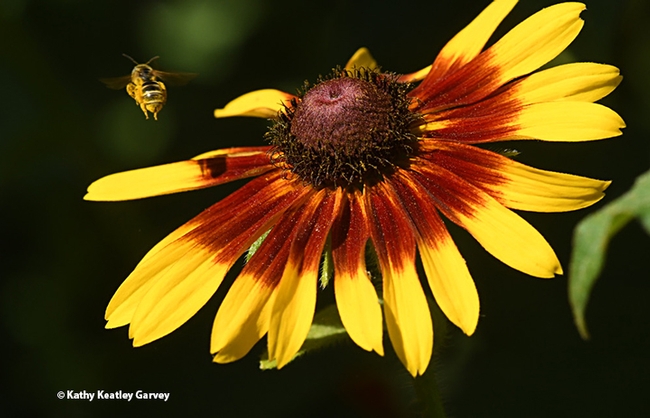
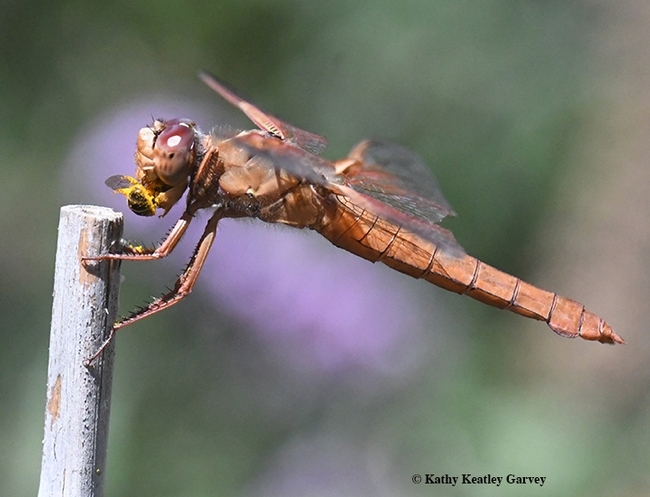
- Author: Kathy Keatley Garvey
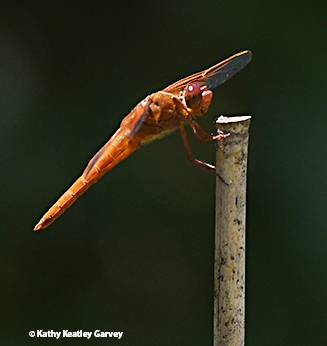
This male made its appearance in our Vacaville pollinator garden on May 17, and hung around long enough for me to capture several images.
Like a lens to a flame...
When folks talk about seeing "a red dragonfly," they might not know the species, but they do know it's firecracker red.
"It was red! Firecracker red!"
Ten fast facts about dragonflies, as provided by the Bohart Museum of Entomology at UC Davis:
- Dragonflies date back before the dinosaur age.
- The largest known prehistoric species of dragonfly, living 300 million years ago, was the Meganeura monyi. Its wingspan measured more than two feet long.
- The largest species today is a South American dragonfly with a wingspan of 7.5 inches. The smallest modern species is an east Asian dragonfly, the libellulid dragonfly, Nannophya pygmaea, with a wingspan of about 3/4 of an inch.
- California is home to approximately 108 species. More than 5000 species are found worldwide.
- Dragonflies help control pests such as mosquitoes, midges and flies, but will also dine on honey bees and butterflies.
- The adults feed by hawking their prey. They dart off a perch to catch prey and often return to the perch to eat.
- Most dragonflies live around lakes, ponds, streams, and marshes; their larvae, known as “nymphs,” are aquatic. Some dragonfly larvae live in bromeliad flowers.
- Dragonflies usually do not bite or sting humans, but if grasped by the abdomen, they may bite to escape.
- The dragonfly is thought to have better eyesight than any other insect. Its compound eyes take up much of the insect's head. Each compound eye has up to 30,000 facets or sensor modules, arranged to provide nearly a 360-degree field of vision. That's why it's difficult to sneak up on them.
- Dragonflies are a common motif in Native American art, displayed on Zuni pottery, Hopi rock art and on Pueblo necklaces. In Japan, they are considered symbols of courage, strength and happiness.
The Bohart Museum, directed by UC Davis distinguished professor Lynn Kimsey, is celebrating its 75th anniversary. It's the home of nearly eight million insect specimens; a live "petting zoo," comprised of Madagascar hissing cockroaches, stick insects (aka "walking sticks"), and tarantulas; and an online gift shop stocked with insect-themed t-shirts, jewelry, books, posters, collecting equipment and the like.
It's temporarily closed due to COVID-19 pandemic precautions. But just you wait...good things are going to happen!
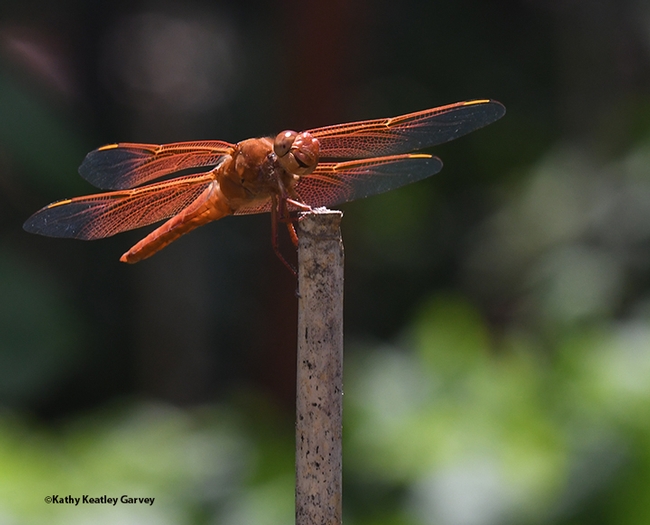
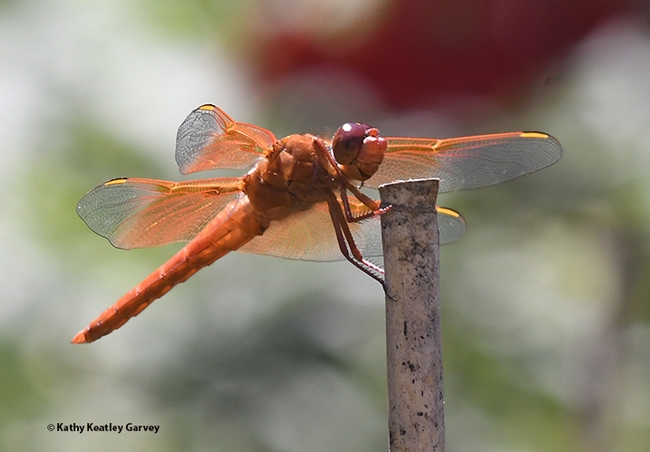
- Author: Kathy Keatley Garvey
Looking for love...or a fast-food snack...or a little sun...
A male flameskimmer dragonfly, Libellula saturata, is a sight to see. The males are fire-engine red or firecracker red, and when they perch on a bamboo stake in your pollinator garden, establishing temporary residency, it's absolutely delightful.
The welcome mat? It's three-fold: a fish pond, nectar sources to attract pollinators, and a series of bamboo stakes just for dragonflies.
This one stayed on his perch for an hour on May 11 in our Vacaville garden, and then moved around a bit to the other stakes, perhaps to escape the photographer, perhaps to grab an insect for a quick snack. Instead of musical chairs, it's musical stakes--magical musical stakes.
“Magic is seeing wonder in nature's every little thing, seeing how wonderful the fireflies are and how magical are the dragonflies.”--
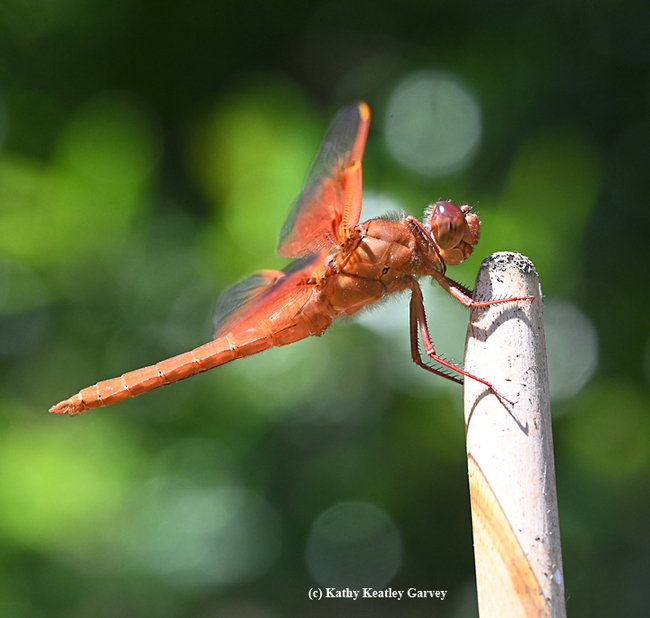
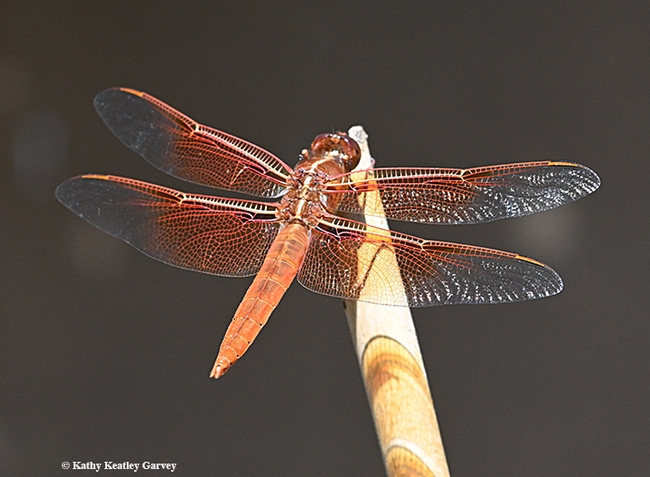
- Author: Kathy Keatley Garvey
Just call it "Fire and Fury in a Pollinator Garden."
That would be the firecracker red flameskimmer dragonfly, Libellula saturata.
They fly into our pollinator garden in Vacaville, Calif., attracted by the lily-padded pond and the all-you-can-eat buffet of flying insects.
They snag their prey in flight--usually a native bee or syprhid fly--and perch on a bamboo stake to eat it.
Table for one, please! No, waiter, I don't need a napkin. Thank you, though.
Native to North America, they are a delight to see and photograph. Sometimes they allow multiple close-up images and that's when we turn into a paparazzi! (To be honest, we'd rather take images of low-flying dragonflies than of high-profile people.)
Their flight reminds us of helicopters. Firecracker red helicopters.
If you've ever thought about the dragonfly being a perfect design for a helicopter, you'd be right.
Check out the website, "Design and the Universe," for its informative piece on "The Dragonfly: The Inspiration for the Helicopter."
"The wings of the dragonfly cannot be folded back on its body. In addition, the way in which the muscles for flight are used in the motion of the wings differs from the rest of insects. Because of these properties, evolutionists claim that dragonflies are "primitive insects."
"In contrast, the flight system of these so-called 'primitive insects' is nothing less than a wonder of design. The world's leading helicopter manufacturer, Sikorsky, finished the design of one of their helicopters by taking the dragonfly as a model.6 IBM, which assisted Sikorsky in this project, started by putting a model of a dragonfly in a computer (IBM 3081). Two thousand special renderings were done on computer in the light of the manoeuvres of the dragonfly in air. Therefore, Sikorsky's model for transporting personnel and artillery was built upon examples derived from dragonflies."
"The body of a dragonfly looks like a helical structure wrapped with metal. Two wings are cross-placed on a body that displays a colour gradation from ice blue to maroon. Because of this structure, the dragonfly is equipped with superb manoeuvrability. No matter at what speed or direction it is already moving, it can immediately stop and start flying in the opposite direction. Alternatively, it can remain suspended in air for the purpose of hunting. At that position, it can move quite swiftly towards its prey. It can accelerate up to a speed that is quite surprising for an insect: 25mph (40km/h), which would be identical to an athlete running 100 metres in the Olympics at 24.4mph (39km/h).
"At this speed, it collides with its prey. The shock of the impact is quite strong. However, the armoury of the dragonfly is both very resistant and very flexible. The flexible structure of its body absorbs the impact of collision. However, the same cannot be said for its prey. The dragonfly's prey would pass out or even be killed by the impact."
"Following the collision, the rear legs of dragonfly take on the role of its most lethal weapons. The legs stretch forward and capture the shocked prey, which is then swiftly dismembered and consumed by powerful jaws."
As for our little male flameskimmer, our firecracker red dragonfly, we watched him ambush prey, unleashing his special brand of fire and fury in a pollinator garden.
Fire and fury in a pollinator garden...
